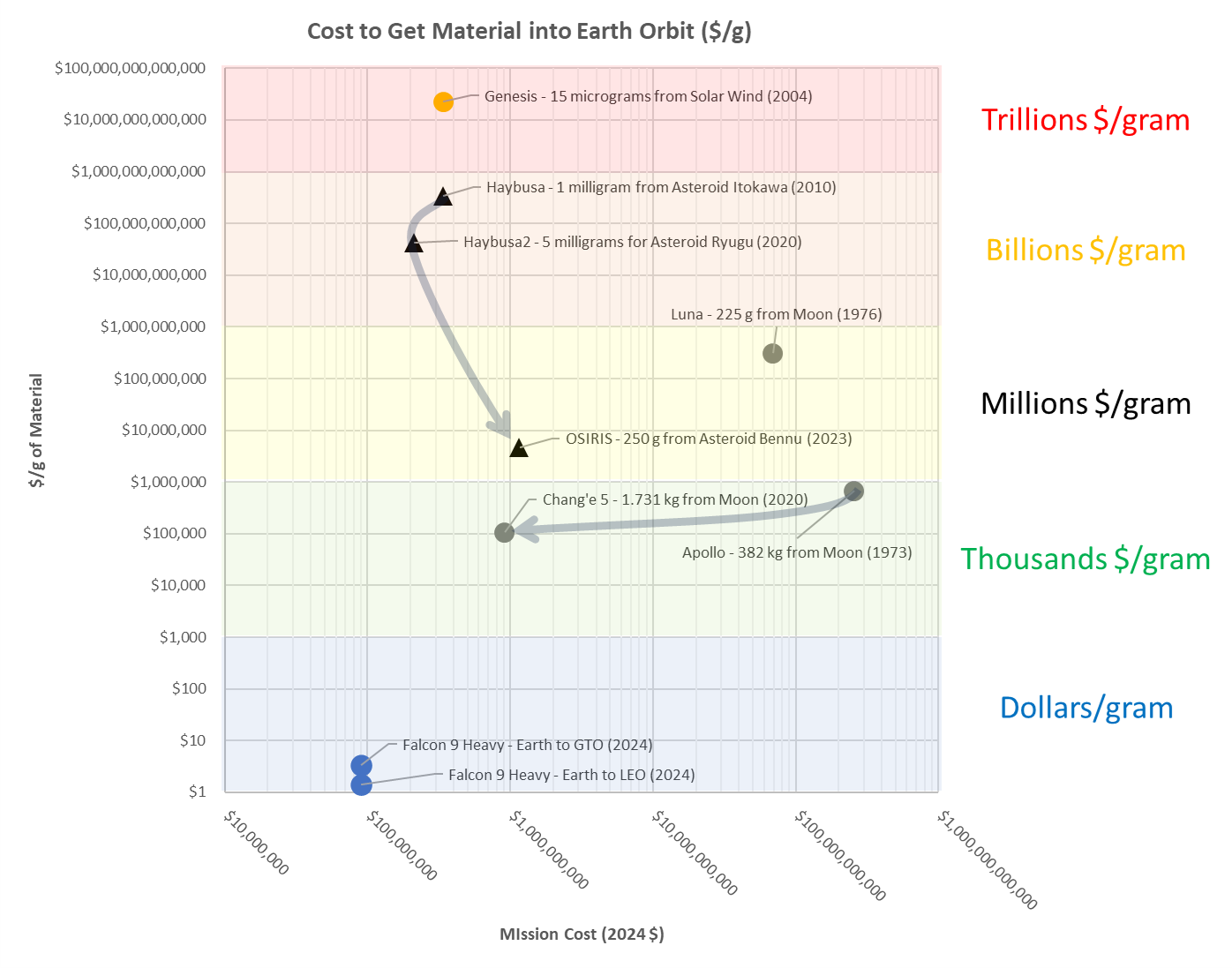The Most Expensive Material On Earth (… is from Space)
At an estimated $62.5 trillion per gram [1], antimatter is the most expensive material on Earth. The most produced to date is about 10 nanograms which were produced at CERN [2].
Only antimatter synthesized in the heart of a particle accelerator is more expensive then matter brought to earth from space.
As of 2024, less than 400 kg of materials have been returned to Earth from other heavenly bodies. The most expensive of these materials was the stuff of the sun. The second most expensive material on Earth is the solar wind captured by the Genesis mission in 2004. Adjusted for inflation, this mission cost about $340 million to capture 15 micrograms of particles from the solar wind. This works out to $22.5 trillion per gram.
Comparatively speaking, asteroid materials are much more affordable ranging from $340 billion per gram to $4 million per gram.
Fortunately, the materials from the moon are even more affordable. 😉 The initial samples returned from the moon worked out to $308 million per gram for the Soviet Luna program and $675 thousand per gram for the Apollo program. Recently, the Chinese Chang'e program returned lunar samples for an estimated $105 thousand per gram.
A space faring civilizations will not happen with materials at these prices.
Eventually, it will be a lot cheaper to get the building blocks of a space civilization from the asteroids and the moon. Before that, there are a lot of things that need to happen for economies of scale to drop the cost.
As Daniel Suarez says in Critical Mass, "The entity with the most mass in orbit, wins." The challenge is how to afford the mass into orbit.
There is one way to get lots of mass in orbit and have it pay for itself.
Space based solar power (SBSP) is being considered now because the changes in launch costs and the economics of energy make it competitive. By building SBSP satellites, 1000's of tons of material will be assembled in orbit. The economics of these systems will have the revenue from beaming energy to earth pay for the satellite lift costs in months. As these systems are retired, they can become the critical mass needed for the next steps in space.
References:
General:
* https://en.wikipedia.org/wiki/Sample-return_mission
* https://space.stackexchange.com/questions/2015/what-is-the-current-cost-per-kg-to-send-something-into-gso-geo
Apollo Program
* https://www.planetary.org/space-policy/cost-of-apollo
* https://curator.jsc.nasa.gov/lunar/
Luna Missions
* https://en.wikipedia.org/wiki/Luna_programme
* https://www.cia.gov/readingroom/docs/DOC_0000316255.pdf
Genesis Mission
* https://en.wikipedia.org/wiki/Genesis_(spacecraft)
* https://nssdc.gsfc.nasa.gov/nmc/spacecraft/display.action?id=2001-034A
OSIRIS Mission
* https://www.planetary.org/space-missions/osiris-rex
* https://www.planetary.org/space-policy/cost-of-osiris-rex
* https://science.nasa.gov/mission/osiris-rex/osiris-rex-faq/
Hayabusa Mission
* https://cosmosmagazine.com/space/astronomy/first-hayabusa2-results-from-asteroid-sampling-mission/
* http://www.astronautix.com/h/hayabusa.html
* https://en.wikipedia.org/wiki/Hayabusa2
* https://nssdc.gsfc.nasa.gov/nmc/spacecraft/display.action
* https://www.space.com/14759-asteroid-sample-mission-hayabusa-2.html
Hayabusa2 Mission
* https://cosmosmagazine.com/space/astronomy/first-hayabusa2-results-from-asteroid-sampling-mission/
* https://nssdc.gsfc.nasa.gov/nmc/spacecraft/display.action?id=2014-076A
* https://www.nytimes.com/2020/12/05/science/japan-asteroid-hayabusa2-woomera.html
Chang'e 5 Mission
* https://www.space.com/43199-chang-e-program.html
* https://www.quora.com/How-much-did-Apollo-cost-per-year-and-how-much-did-China-s-lunar-mission-cost-per-year
* https://www.space.com/43199-chang-e-program.html
* https://news.cgtn.com/news/2019-07-30/China-s-latest-Moon-mission-cost-almost-a-kilometer-of-subway-IKG4Wjaeic/index.html
Notes on analysis:
* In general, all return materials costs were estimated using the missions costs for a satellite and its operations. Primary sources of cost information were used where possible.
* The costs for lunar sample returns were estimated from the full program including intermediate missions. The US lunar retrieval cost was calculated from the Gemini & Apollo program costs. The Luna retrieval costs were calculated from the Soviet lunar program through 1964 w/ CIA estimated for future spending. The Chinese lunar sample cost was calculated from the series of Chang'e missions leading up the Chang'e 5 mission.
* The only published information found on Chang'e 5 was a comparison of the mission cost to a length of subway!
* The costs estimates for Hayabusa were indirectly calculated from statements on Hayabusa2 missions costs.

